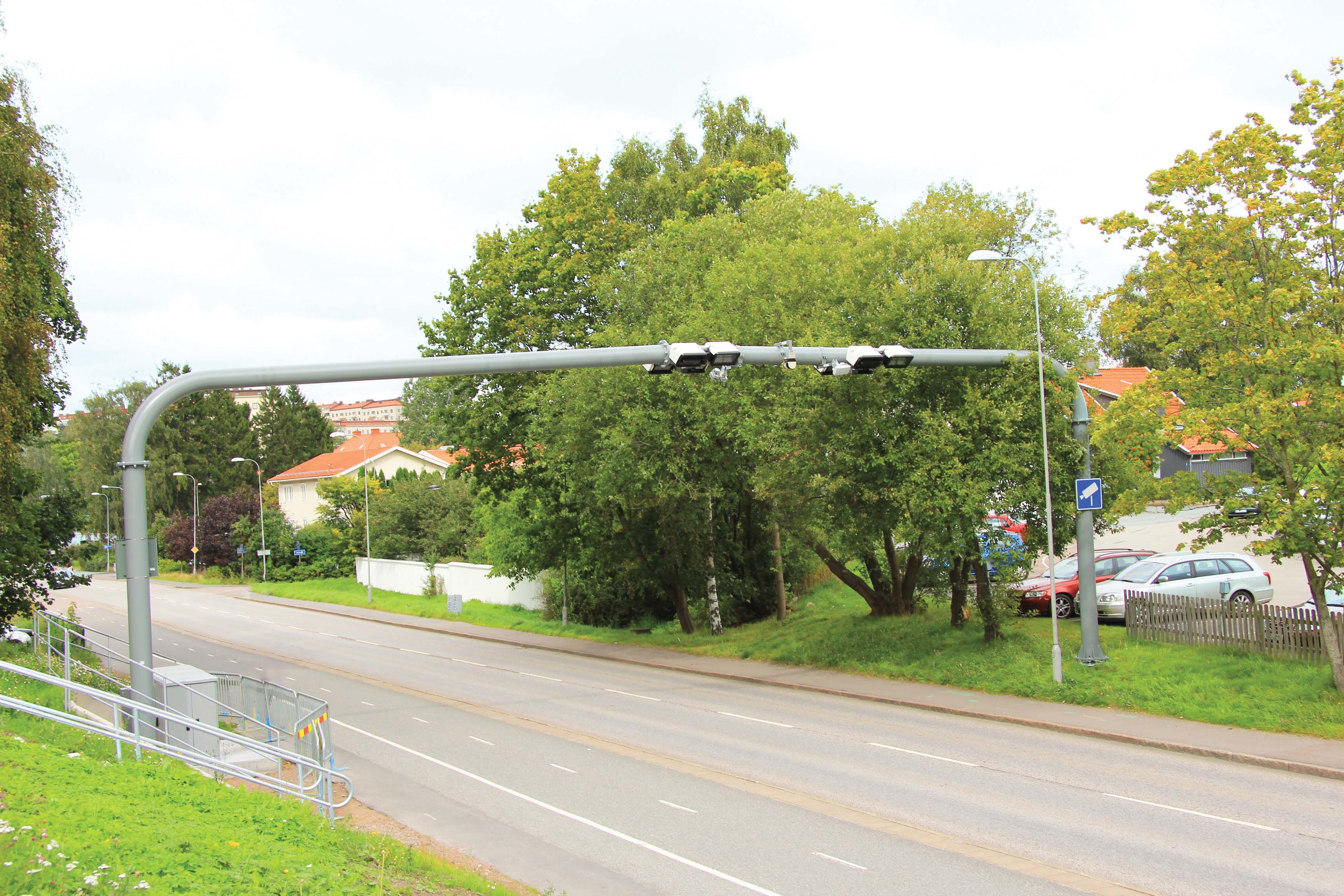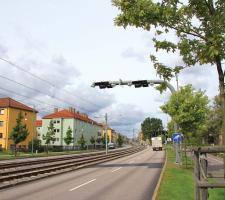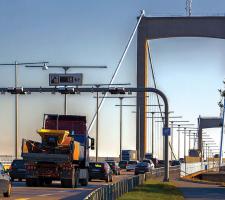
Aesthetically the single gantry design is less intrusive and fits in with Gothenburg’s plans
A year after it went live, Colin Sowman examines the technology used for Gothenburg’s congestion charging system and the effect the scheme has had on commuters.
When it comes to long-term planning, the Scandinavians take some beating.The West Swedish Agreement is a case in point. Introduced in 2009, the Agreement runs through to around 2027 and aims to create an attractive, sustainable and growing region, and over that timescale the number of journeys is expected to increase by a third.
Therefore the Agreement includes new roads and bus lanes, additional rail capacity, new footpaths and bicycle paths, more parking for bicycles and cars as well as improved traffic information - and a congestion charge for Gothenburg.
The Agreement introduces far-reaching plans for transport in terms of major infrastructure projects such as the new Marieholm road tunnel beneath the Göta Älv river (and a movable bridge above) to be started in 2015 which by 2020 will link the E20, E6 and E45 with the Lundby bypass. In 2018 a 6km long tunnel will be started for a double railway track beneath Gothenburg as part of the new 8km West Link; a plan that includes four new commuter stations. Additional commuter trains are already on order and existing platforms are being lengthened to increase capacity. An additional 55km of new bus lanes will be added to the current 35km while bicycle paths and commuter parking for cars and bicycles are being built and extended.
The implementation of a congestion charge is expected to raise SEK14bn (US$2.2bn) which will be used to part fund the SEK34bn (US$5.2bn) Agreement and make it the second largest contributor after the SEK17bn (US$2.6bn) provided by the state.
Building a large infrastructure in the heart of the city to collect the congestion charge would run counter to the Agreement’s main aim. So the city’s authorities wanted to minimise both the visual impact and cost of the multilane free flow (MLFF) congestion charging infrastructure. To do this it wanted all the necessary equipment to be mounted on gantries following a selected design at some 40 charging points.
This posed a number of challenges for the system supplier108 Q-Free, as its global account manager Steinar Furan explains:
“Gothenburg had no road user charging system operational prior to the launch of the congestion charging system. In dialogue with the authorities in Gothenburg, it was decided to develop a bespoke Single Gantry MLFF design. This was due to the limited space and the aesthetic requirements. A single gantry MLFF station minimises the visual impact on the surrounding environment and requires little space for installation.
“Technically the challenge in a single gantry multilane free-flow (SGMLFF) operation is to be able to combine the output of several sensors into a single ‘package’of information and attribute it to a unique vehicle. To overcome these challenges, the SGMLFF roadside system uses both front- and rear-view ALPR imaging systems, a vehicle detection system to trigger the ALPR and there is the option of a vehicle classification system allowing future differentiated charges for various vehicle types.
A dedicated short range communications system (DSRC) meeting the CEN (the European committee on standardisation) standards is included on the gantry to provide interoperability for vehicles fitted with the1702 EasyGO transponders which are widely used across Sweden, Norway, Denmark and Austria. Tracking cameras follow each vehicle as it progresses through the detection area. We have developed tracking technology which ensures that the SGMLFF tracks each vehicle that passes the station.
“Performance-wise the SGMLFF system is similar to the traditional twin-gantry MLFF configurations. It also enables system owners to enhance system functionality. An example is the ability to define the spot where charging takes place in any part of the station’s detection area. This means that inbound and outbound traffic, for instance, can be charged at different positions at the station.”
The increased accuracy also ensures that vehicles travelling on a parallel, free-to-use section of road are not charged erroneously and has a positive effect on public acceptance.
A major consideration is the cost and in that aspect Furan says the elimination of a second gantry at the charging station leads to substantial cost saving during the build-phase of the project - in operation, both systems’ service costs are similar.
While it is relatively easy to sort the technology, human behaviour is far more difficult – potentially impossible – to control as the authorities in Gothenburg discovered. Having had traffic counting technology in place before the charge was implemented, quantifying the effect of the congestion charge on traffic levels was relatively straightforward, albeit some weather effects have to be factored into the results.
In January 2013, the First month the congestion charge was levied, the volume of traffic through the 38 charge points was 20% lower than a year earlier while inner city traffic saw an even bigger decline of 22%. However, month on month the volume of traffic both through the charging points and in the city centre has increased.
As figures released by the World Bank Group indicate that Sweden’s GDP declined over the period, it is unlikely that this increase in traffic was caused by economic effects.
While comparative figures for December were distorted by heavy snowfalls, in November 2013 the volume of traffic passing the charge points averaged 588,200 meaning it was only 11% lower than the previous year. Traffic in the inner city was only 8% below the previous year.
Conversely, the number of passengers using the buses, trams and train saw a month on month increase throughout the year.
The biggest winners are the express buses in and around the city where an initial boost of around 10% finished the year with passenger numbers 21% higher than a year earlier.
By the end of 2013 train passenger numbers had risen by 15%, transit bus ridership in Gothenburg finished 13% higher and the trams recorded an 11% increase.
The number of multimodal journeys also increased by 10% and the car park occupancy at park and ride facilities rose from an average of less than 70% to 85%. There are no statistics regarding the effect of the changes on the number of journeys made by bicycle or on foot.
Those deciding to continue driving into the city are charged if they enter between 06.00 and 18.30. Prices vary between SEK8 (US$1.2), SEK13 (US$2) and SEK18 (US$2.75) depending on the time of day and the maximum cost for a day is SEK60 (US$9.1). Unlike speed enforcement in Sweden, the congestion charge is invoiced to the registered owner of the vehicle each month according to how many times they enter the city and when. If the invoice is not settled 60 days after the end of the charging period it attracts a SEK500 (US$75.5) surcharge and if the vehicle owner still refuses to pay their details are passed to the enforcement authority.
Transportstyrelsen, the2124 Swedish Transport Agency, told ITS International that financially the scheme was performing in line with expectations. And despite the fall off in the traffic reduction, by November 2013 there were still 73,000 fewer vehicles entering the city each day than the previous year. This means both travel times and travel time variation remain lower than before the scheme was implemented.
In combining the introduction of the charge with the launch of a major upgrade of the road network and the public transport alternatives, the Agency says travellers have responded well to the measures - albeit around 2.5% of vehicles passing the charge point incurred penalties. So, as a relatively inexpensive and effective system that is performing financially to plan and been well accepted by the travelling public, Gothenburg appears to have come up with a winning formula for its travellers.
When it comes to long-term planning, the Scandinavians take some beating.The West Swedish Agreement is a case in point. Introduced in 2009, the Agreement runs through to around 2027 and aims to create an attractive, sustainable and growing region, and over that timescale the number of journeys is expected to increase by a third.
Therefore the Agreement includes new roads and bus lanes, additional rail capacity, new footpaths and bicycle paths, more parking for bicycles and cars as well as improved traffic information - and a congestion charge for Gothenburg.
The Agreement introduces far-reaching plans for transport in terms of major infrastructure projects such as the new Marieholm road tunnel beneath the Göta Älv river (and a movable bridge above) to be started in 2015 which by 2020 will link the E20, E6 and E45 with the Lundby bypass. In 2018 a 6km long tunnel will be started for a double railway track beneath Gothenburg as part of the new 8km West Link; a plan that includes four new commuter stations. Additional commuter trains are already on order and existing platforms are being lengthened to increase capacity. An additional 55km of new bus lanes will be added to the current 35km while bicycle paths and commuter parking for cars and bicycles are being built and extended.
The implementation of a congestion charge is expected to raise SEK14bn (US$2.2bn) which will be used to part fund the SEK34bn (US$5.2bn) Agreement and make it the second largest contributor after the SEK17bn (US$2.6bn) provided by the state.
Building a large infrastructure in the heart of the city to collect the congestion charge would run counter to the Agreement’s main aim. So the city’s authorities wanted to minimise both the visual impact and cost of the multilane free flow (MLFF) congestion charging infrastructure. To do this it wanted all the necessary equipment to be mounted on gantries following a selected design at some 40 charging points.
This posed a number of challenges for the system supplier
“Gothenburg had no road user charging system operational prior to the launch of the congestion charging system. In dialogue with the authorities in Gothenburg, it was decided to develop a bespoke Single Gantry MLFF design. This was due to the limited space and the aesthetic requirements. A single gantry MLFF station minimises the visual impact on the surrounding environment and requires little space for installation.
“Technically the challenge in a single gantry multilane free-flow (SGMLFF) operation is to be able to combine the output of several sensors into a single ‘package’of information and attribute it to a unique vehicle. To overcome these challenges, the SGMLFF roadside system uses both front- and rear-view ALPR imaging systems, a vehicle detection system to trigger the ALPR and there is the option of a vehicle classification system allowing future differentiated charges for various vehicle types.
A dedicated short range communications system (DSRC) meeting the CEN (the European committee on standardisation) standards is included on the gantry to provide interoperability for vehicles fitted with the
“Performance-wise the SGMLFF system is similar to the traditional twin-gantry MLFF configurations. It also enables system owners to enhance system functionality. An example is the ability to define the spot where charging takes place in any part of the station’s detection area. This means that inbound and outbound traffic, for instance, can be charged at different positions at the station.”
The increased accuracy also ensures that vehicles travelling on a parallel, free-to-use section of road are not charged erroneously and has a positive effect on public acceptance.
A major consideration is the cost and in that aspect Furan says the elimination of a second gantry at the charging station leads to substantial cost saving during the build-phase of the project - in operation, both systems’ service costs are similar.
While it is relatively easy to sort the technology, human behaviour is far more difficult – potentially impossible – to control as the authorities in Gothenburg discovered. Having had traffic counting technology in place before the charge was implemented, quantifying the effect of the congestion charge on traffic levels was relatively straightforward, albeit some weather effects have to be factored into the results.
In January 2013, the First month the congestion charge was levied, the volume of traffic through the 38 charge points was 20% lower than a year earlier while inner city traffic saw an even bigger decline of 22%. However, month on month the volume of traffic both through the charging points and in the city centre has increased.
As figures released by the World Bank Group indicate that Sweden’s GDP declined over the period, it is unlikely that this increase in traffic was caused by economic effects.
While comparative figures for December were distorted by heavy snowfalls, in November 2013 the volume of traffic passing the charge points averaged 588,200 meaning it was only 11% lower than the previous year. Traffic in the inner city was only 8% below the previous year.
Conversely, the number of passengers using the buses, trams and train saw a month on month increase throughout the year.
The biggest winners are the express buses in and around the city where an initial boost of around 10% finished the year with passenger numbers 21% higher than a year earlier.
By the end of 2013 train passenger numbers had risen by 15%, transit bus ridership in Gothenburg finished 13% higher and the trams recorded an 11% increase.
The number of multimodal journeys also increased by 10% and the car park occupancy at park and ride facilities rose from an average of less than 70% to 85%. There are no statistics regarding the effect of the changes on the number of journeys made by bicycle or on foot.
Those deciding to continue driving into the city are charged if they enter between 06.00 and 18.30. Prices vary between SEK8 (US$1.2), SEK13 (US$2) and SEK18 (US$2.75) depending on the time of day and the maximum cost for a day is SEK60 (US$9.1). Unlike speed enforcement in Sweden, the congestion charge is invoiced to the registered owner of the vehicle each month according to how many times they enter the city and when. If the invoice is not settled 60 days after the end of the charging period it attracts a SEK500 (US$75.5) surcharge and if the vehicle owner still refuses to pay their details are passed to the enforcement authority.
Transportstyrelsen, the
In combining the introduction of the charge with the launch of a major upgrade of the road network and the public transport alternatives, the Agency says travellers have responded well to the measures - albeit around 2.5% of vehicles passing the charge point incurred penalties. So, as a relatively inexpensive and effective system that is performing financially to plan and been well accepted by the travelling public, Gothenburg appears to have come up with a winning formula for its travellers.















